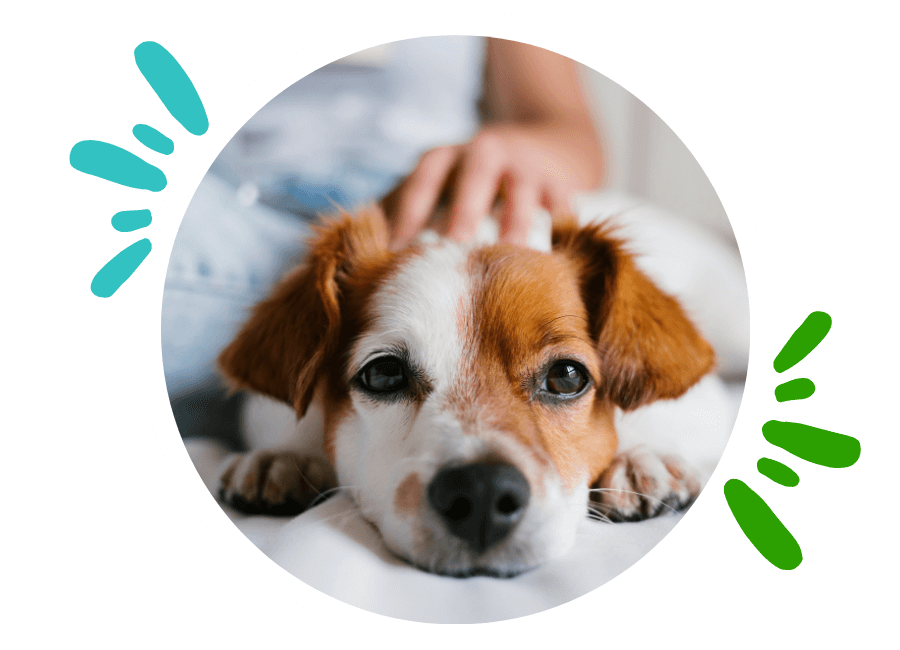When you pet your dog, they may pee due to excitement or submissive urination. Act calmly, avoid direct eye contact, and let your dog calm down before greeting them affectionately but calmly.
Ignore the dog when visitors arrive and take them outside to urinate if necessary. If you’ve ever experienced the frustrating situation of your dog peeing when you pet them, you’re not alone. Many dog owners have wondered why their furry friends exhibit this behavior.
It can be embarrassing and inconvenient, especially when you have guests over. Understanding the reasons behind this behavior can help you address the issue and find ways to prevent it. We will explore the causes of why dogs pee when being petted, as well as provide some practical tips on how to manage and train your dog to avoid this behavior. So, let’s delve into the world of pet behavior and discover the answers you’ve been seeking.

Credit: crystalriveranimalhospital.com
Understanding Submissive Urination
Submissive urination in dogs, including when they pee when petted, is a common behavior caused by excitement, fear, or submission. To address submissive urination, it’s important to remain calm, avoid direct eye contact, and greet the dog calmly. Taking the dog outside to urinate before greeting them can also help prevent this behavior.
What Is Submissive Urination?
Submissive urination refers to the involuntary loss of urine that occurs when a dog feels extremely anxious, fearful, or intimidated. It is a common behavior seen in young dogs during greetings or interactions with humans or other animals. This behavior is not a sign of disobedience or lack of house training, but rather a way for the dog to communicate their submission and appeasement to avoid any potential conflict.Causes Of Submissive Urination
Submissive urination can be caused by a variety of factors, including:1. Lack of socialization: Dogs who have not been adequately socialized during their early developmental stages may be more prone to submissive urination.2. Fear and anxiety: Dogs that are naturally shy or easily frightened may exhibit submissive urination as a response to perceived threats or stressful situations.3. Rough or aggressive handling: Dogs that have been subjected to rough handling or punishment-based training methods may develop submissive urination as a fear response.4. Genetic predisposition: Some dogs may have a genetic predisposition towards submissive urination, making them more prone to this behavior.5. Medical issues: In some cases, submissive urination may be a result of urinary tract infections, bladder issues, or other medical conditions. It is important to rule out any underlying health problems by consulting with a veterinarian.Common Signs Of Submissive Urination
Recognizing the signs of submissive urination can help dog owners address the issue effectively. Some common signs include:1. Urinating when greeted: Dogs may urinate when they are approached or petted by their owners or other individuals. This behavior is often accompanied by a submissive posture, such as crouching, tucking the tail between the legs, and averting the gaze. 2. Subdued behavior: Dogs with submissive urination may exhibit signs of fear or anxiety, such as trembling, avoiding eye contact, or cowering.3. Excessive submissiveness: These dogs may display exaggerated submissiveness, such as rolling over and exposing their belly, in an attempt to appease and avoid any potential conflict.4. Inappropriate urination: Submissive urination may occur in various contexts, such as during playtime, training sessions, or when meeting new people or animals.It is crucial to approach a dog with submissive urination issues with patience, understanding, and positive reinforcement techniques. Punishment or scolding can exacerbate the problem and lead to increased anxiety and submissive behaviors.Managing Submissive Urination
Submissive urination in dogs, such as peeing when petted, can be managed by acting calmly, not making direct eye contact, and letting the dog calm down before greeting them affectionately but calmly. Ignoring the dog when visitors arrive can also help.
Submissive urination is an instinctual response that typically occurs when a dog feels excited, shy, anxious, or scared.
Avoid Triggering Submissive Urination
Submissive urination in dogs can be triggered by certain actions or behaviors. It’s important to be aware of these triggers and take steps to avoid them. Here are some tips to help you avoid triggering submissive urination:
- Avoid direct eye contact: Direct eye contact can be seen as intimidating or threatening to some dogs, leading to submissive urination. Instead, try to maintain a soft gaze or look away.
- Avoid sudden movements: Sudden movements or gestures can startle a dog and trigger submissive urination. Move slowly and calmly when interacting with your dog.
- Avoid loud or excited voices: Dogs are sensitive to the tone of your voice. Speaking loudly or excitedly can cause your dog to feel anxious or submissive. Use a calm and soothing tone when communicating with your dog.
- Avoid reaching over the dog: Reaching over a dog can be perceived as a threat, especially when they are already feeling submissive. Instead, squat down to their level or approach from the side.
- Avoid physical punishment or scolding: Punishment or scolding can make a submissive dog even more anxious and may worsen the issue. Use positive reinforcement and reward-based training methods instead.
Building Confidence And Trust
Building your dog’s confidence and trust can help alleviate submissive urination. Here are some strategies to help boost your dog’s confidence:
- Provide a consistent routine: Dogs thrive on routine and knowing what to expect. Establish a consistent schedule for feeding, exercise, and training.
- Encourage positive social interactions: Expose your dog to positive social experiences with other dogs and people. Gradually expose them to new situations and environments, rewarding them for calm and confident behavior.
- Offer plenty of mental and physical stimulation: Engage your dog in interactive play sessions and provide mental stimulation through puzzle toys and training exercises. Regular exercise can also help reduce anxiety.
- Use positive reinforcement: Reward your dog for desired behaviors and ignore or redirect unwanted behaviors. This positive reinforcement helps build confidence and strengthens the bond between you and your dog.
Training Techniques For Submissive Urination
When it comes to training techniques for submissive urination, consistency and patience are key. Here are some techniques that can help address submissive urination:
- Ignore the behavior: When your dog exhibits submissive urination, it’s important not to scold or punish them. This can exacerbate the issue. Instead, calmly and quietly clean up the urine and redirect your dog’s attention to a positive activity.
- Desensitization exercises: Gradually expose your dog to triggers that may cause submissive urination, starting with low-intensity situations and gradually increasing the level of exposure. Reward your dog for remaining calm and confident.
- Counter-conditioning: Pair positive experiences and rewards with situations that would normally trigger submissive urination. This can help your dog develop positive associations and reduce anxiety.
- Consult a professional trainer or behaviorist: If the issue persists or worsens, it may be beneficial to seek guidance from a professional dog trainer or animal behaviorist who can provide personalized advice and training techniques.
Seeking Professional Help
If your dog pees when you pet him, it may be due to submissive urination caused by excitement or anxiety. Seeking professional help can provide guidance on how to address this behavior and train your dog to eliminate this habit.
When To Consult A Veterinarian
If your dog consistently pees when you pet him, it’s essential to consult a veterinarian. While submissive urination is a common issue, it’s crucial to rule out any underlying medical conditions that may be contributing to this behavior. A veterinarian can conduct a thorough examination to determine if there are any physical causes, such as urinary tract infections or bladder problems. They can also provide guidance on any necessary medical treatments or interventions.Working With A Dog Behaviorist Or Trainer
In addition to consulting a veterinarian, it may be beneficial to seek the assistance of a professional dog behaviorist or trainer. These experts specialize in understanding canine behavior and can provide guidance, training, and techniques to address submissive urination in your dog. They will work with you to develop a personalized training plan that focuses on building your dog’s confidence and helping them overcome their submissive urination tendencies. With their expertise, they can help you identify triggers and provide effective training methods to modify this behavior.Medical Conditions Associated With Submissive Urination
Submissive urination can sometimes be a symptom of underlying medical conditions. Here are a few medical conditions that may contribute to or exacerbate submissive urination in dogs:| Medical Condition | Description |
|---|---|
| Urinary Tract Infections (UTIs) | A bacterial infection in the urinary tract, causing discomfort and frequent urination. |
| Bladder Stones | Hard mineral formations that can block the urinary tract, leading to urinary problems. |
| Incontinence | A condition where the dog has little to no control over their urinary sphincter, causing involuntary urination. |
| Bladder Infections | An infection in the bladder that can cause irritation and abnormal urination. |
| Hormonal Imbalances | Changes in hormone levels can affect the dog’s urinary system and contribute to submissive urination. |

Credit: www.theguardian.com

Credit: www.newyorker.com
Frequently Asked Questions On Why Does My Dog Pee When I Pet Him
How Can I Stop My Dog From Peeing When I Pet Him?
To stop your dog from peeing when you pet him, remain calm, avoid excitement, don’t pet him, and avoid eye contact. Take the dog outside to urinate, and once he calms down, greet him calmly. When visitors arrive, ask them to ignore the dog initially.
Why Does My Dog Pee When I Get Petted?
Submissive urination is a normal behavior in dogs, especially when they are excited or feel submissive. To stop your dog from peeing when you pet them, remain calm, avoid eye contact, don’t talk or move excitably, and take them outside to urinate before greeting them affectionately but calmly.
Ask visitors to ignore the dog upon arrival.
Does Submissive Peeing Go Away?
Submissive peeing in dogs can improve over time. Act calmly and avoid direct eye contact when greeting or petting the dog. Take them outside to urinate before interaction and greet them calmly. Visitors should also ignore the dog initially. With proper training and socialization, submissive peeing can diminish as the dog grows older.
Do Dogs Grow Out Of Excited Peeing?
Excited peeing in dogs is a common behavior that usually stops as they grow older, usually by the age of one year. To prevent it, act calmly, avoid eye contact, and don’t pet the dog when they are excited. Take them outside to urinate and greet them calmly after they have calmed down.
Ignore the dog when visitors arrive.
Conclusion
Peeing when being petted is a common behavior in dogs known as submissive urination. It usually occurs when they are excited or anxious. To address this issue, it is essential to remain calm, avoid direct eye contact, and not make any sudden movements.
Taking the dog outside to relieve themselves before greeting them calmly can also help. Additionally, instructing visitors to ignore the dog upon arrival can minimize the submissive urination. Remember, with patience and consistency, this behavior can be managed effectively.



